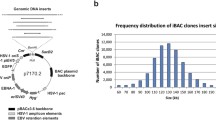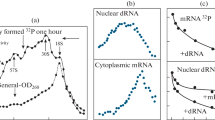Abstract
Recently we have purified to homogeneity and characterized an interferon-induced human protein (p78 protein) which is the equivalent of the interferon-induced murine Mx protein responsible for a specific antiviral state against influenza virus infection. A cDNA library was constructed using mRNAs from interferon-induced human diploid fibroblasts. cDNA clones coding for the human p78 protein were identified and used to determine the chromosomal location of the corresponding gene (termedIFI-78K gene) by hybridization to DNA from a panel of human x rodent somatic cell hybrids. The newly identified gene is located on chromosome 21. This has been confirmed by the observation of a gene dosage effect using chromosome 21 trisomic cells (fibroblasts derived from Down's syndrome patients). Among all interferon-inducible genes mapped so far, theIFI-78K gene is the only one located on chromosome 21, together with the gene for the receptor of type I interferon. Our results also provide further evidence for homology between human chromosome 21 and mouse chromosome 16, since the gene encoding the mouse Mx protein (the presumed mouse homolog protein of human p78 protein) has been assigned to chromosome 16.
Similar content being viewed by others
Literature cited
Horisberger, M.A., Staeheli, P., and Haller, O. (1983).Proc. Natl. Acad. Sci. U.S.A. 80:1910–1914.
Staeheli, P., Haller, O., Boll, W., Lindenmann, J., and Weissmann, C. (1986).Cell 44:147–158.
Horisberger, M.A., and Hochkeppel, H.K. (1987).J. Interferon Res. 7:331–343.
Staeheli, P., and Haller, O. (1985).Mol. Cell. Biol. 5:2150–2153.
Staeheli, P., Horisberger, M.A., and Haller, O. (1984).Virology 132:456–461.
Horisberger, M.A., and Hochkeppel, H.K. (1985).J. Biol Chem. 260:1730–1733.
Staeheli, P., Pravtcheva, D., Lundin, L.G., Acklin, M., Ruddle, F.H., Lindenmann, J., and Haller, O. (1986).J. Virol. 58:967–969.
Cox, D.R., Epstein, L.B., and Epstein, C.J. (1980).Proc. Natl. Acad. Sci. U.S.A. 77:2168–2172.
Cox, D.R., Goldblatt, D., and Epstein, C.J. (1981).Am. J. Hum. Genet. 33:145A.
Gubler, U., and Hoffmann, B.J. (1983).Gene 25:263–269.
Wathelet, M., Moutschen, S., Defilippi, P., Cravador, A., Collet, M., Huez, G., and Content, J. (1986).Eur. J. Biochem. 155:11–17.
Pan, S., and Doherty, J.P. (1986).Anal. Biochem. 156:305–306.
Mason, P.J., and Williams, J.G. (1986). InNucleic Acid Hybridization. A Practical Approach, (eds.) Hames, B.D. and Higgins, S.J. (IRL Press, Oxford), pp. 128–131.
Wathelet, M., Moutschen, S., Cravador, L., DeWit, L., Defilippi, P., Huez, G., and Content, J. (1986).FEBS Lett. 196:113–120.
Melton, D.A., Krieg, P.A., Rebagliati, M.R., Maniatis, T., Zinn, K., and Green, M.R. (1984).Nucleic Acids Res. 12:7035–7056.
Islam, M.Q., and Levan, G. (1987).Hereditas 107:127–130.
Revel, M., and Chebath, J. (1986).Trends Biochem. Sci. 11:166–170.
Wood, W.I., Gitschier, J., Lasky, L.A., and Lawn, R.M. (1985).Proc. Natl. Acad. Sci. U.S.A. 82:1585–1588.
Williams, B.R.G., Saunders, M.E., and Williard, H.F. (1986).Somat. Cell. Mol. Genet. 12:403–486.
Evans, H.J., Buckland, R.A., and Pardue, M.L. (1974).Chromosome 48:405–426.
Schmickel, R.D., and Knoller, M. (1977).Pediatr. Res. 11:929–935.
Raziuddin, A., Sarkar, F.H., Dutkowski, R., Shulman, L., and Ruddle, F.H. (1984).Proc. Natl. Acad. Sci. U.S.A. 81:5504–5508.
Moore, E.E.C., Jones, C., Kao, F.T., and Oates, D.C. (1977).Am. J. Hum. Genet. 29:389–396.
Patterson, D., Graw, S., and Jones, C. (1981).Proc. Natl. Acad. Sci. U.S.A. 78:408–409.
Vora, S., and Franke, U. (1981).Proc. Natl. Acad. Sci. U.S.A. 78:3738–3742.
Skovby, F., Krassikoff, N., and Franke, U. (1984).Hum. Genet. 65:291–294.
Kang, J., Lemaire, H.G., Unterbeck, A., Salbaum, J.M., Masters, C.L., Grzeshik, K.H., Multhaup, G., Beyreuther, K., and Müller-Hill, B. (1987).Nature 325:733–736.
Robakis, N.K., Wisniewski, H.M., Jenkins, E.C., Devine-Gage, E.A., Houck, G.E., Yao, X.L., Ramakrishna, N., Wolfe, G., Silverman, W.P., and Brown, W.T. (1987).Lancet 1:384–385.
Goldgaber, D., Lerman, M.I., McBride, O.W., Saffiotti, U., and Gadjusek, D.C. (1987).Science 235:877–880.
Tanzi, R.E., Gusella, J.F., Watkins, P.C., Bruns, G.A.P., St. George-Hyslop, P., Van Keuren, M.L., Patterson, D., Pagan, S., Kurnit, D.M., and Neve, R.L. (1987).Science 235:880–884.
St George-Hyslop, P.H., Tanzi, R.E., Polinsky, R.J., Haines, J.L., Nee, L., Watkins, P.C., Myers, R.H., Feldman, R.G., Pollen, D., Drachman, D., Growdon, J., Bruni, A., Foncin, J.F., Salmon, D., Frommelt, P., Amaducci, L., Sorbi, S., Piacentini, S., Stewart, G.D., Hobbs, W.J., Conneally, P.M., and Gusella, J.F. (1987).Science 235:885–890.
Watson, D.K., McWilliams-Smith, M.J., Kozak, C., Reeves, R., Gearhart, J., Nunn, M.F., Nash, W., Fowle, J.R., Duesberg, P., Papas, T.S., and O'Brien, S.J. (1986).Proc. Natl. Acad. Sci. U.S.A. 83:1792–1796.
Rao, V.N., Papas, T.S., and Reddy, E.S. (1987).Science 237:635–639.
Francke, U., and Taggart, R.T. (1979).Proc. Natl. Acad. Sci. U.S.A. 76:5320–5233.
Lin, P.F., Slate, D.L., Lawyer, F.C., and Ruddle, F.H. (1980).Science 209:285–287.
Tan, Y.H., Tischfield, J., and Ruddle, F.H. (1973).J. Exp. Med. 137:317–330.
Jung, V., Rashidbaigi, A., Jones, C., Tischfield, J.A., Shows, T.B., and Pestka, S. (1987).Proc. Natl. Acad. Sci. 84:4151–4155.
Meier, E., Arnheiter, H., and Haller, O. (1986)J. Interferon Res. 6:109.
Horisberger, M.A. (1988).Virology 162:181–186.
Author information
Authors and Affiliations
Rights and permissions
About this article
Cite this article
Horisberger, M.A., Wathelet, M., Szpirer, J. et al. cDNA cloning and assignment to chromosome 21 ofIFI-78K gene, the human equivalent of murineMx gene. Somat Cell Mol Genet 14, 123–131 (1988). https://doi.org/10.1007/BF01534397
Received:
Revised:
Issue Date:
DOI: https://doi.org/10.1007/BF01534397




